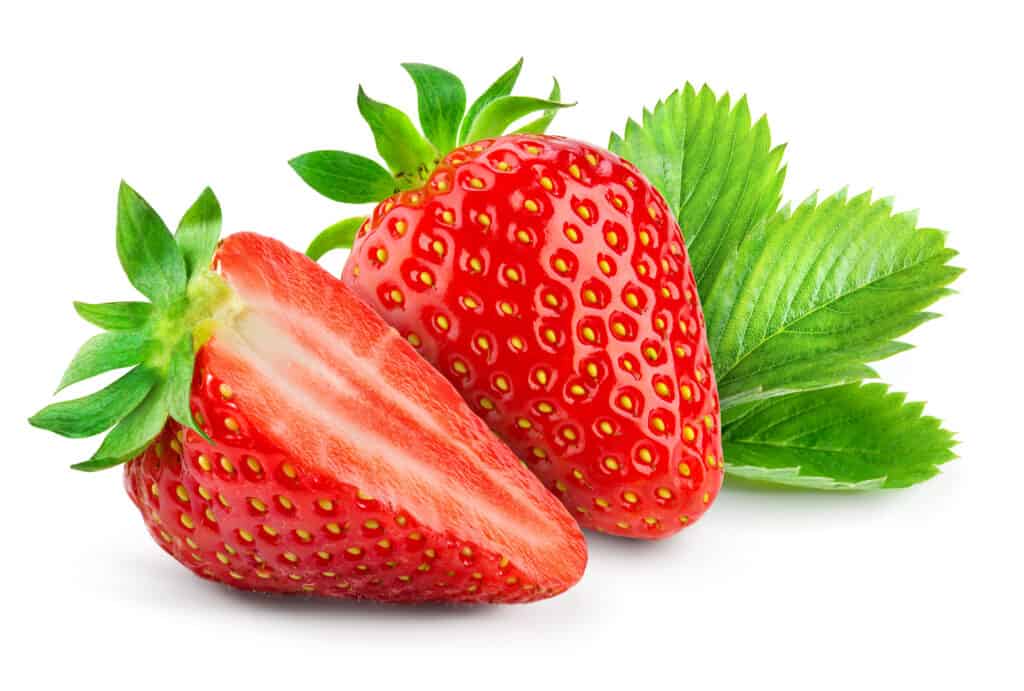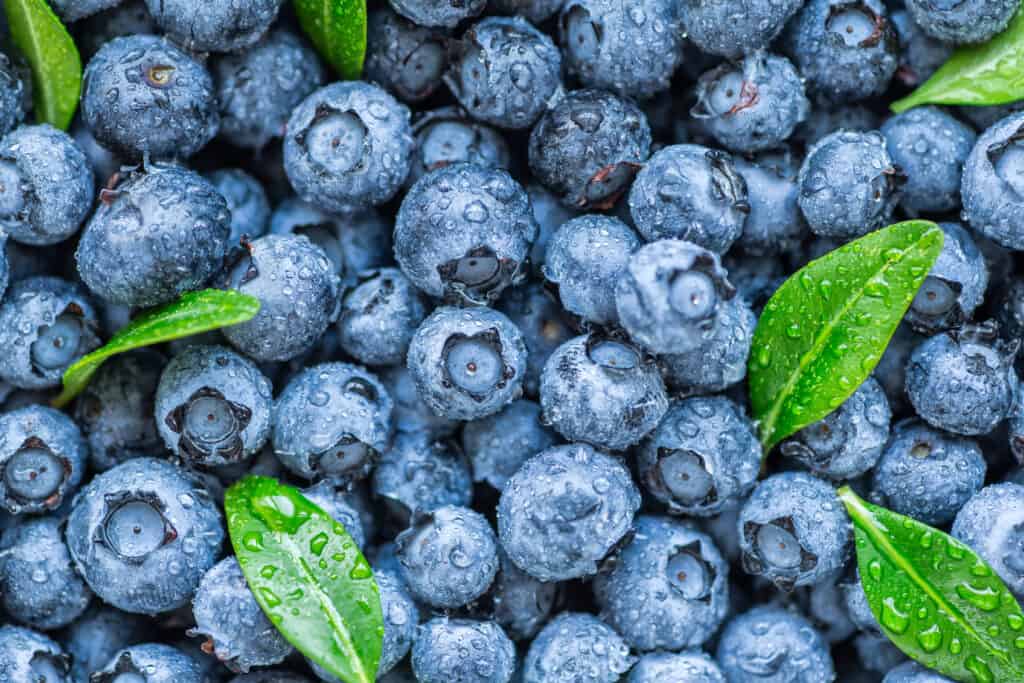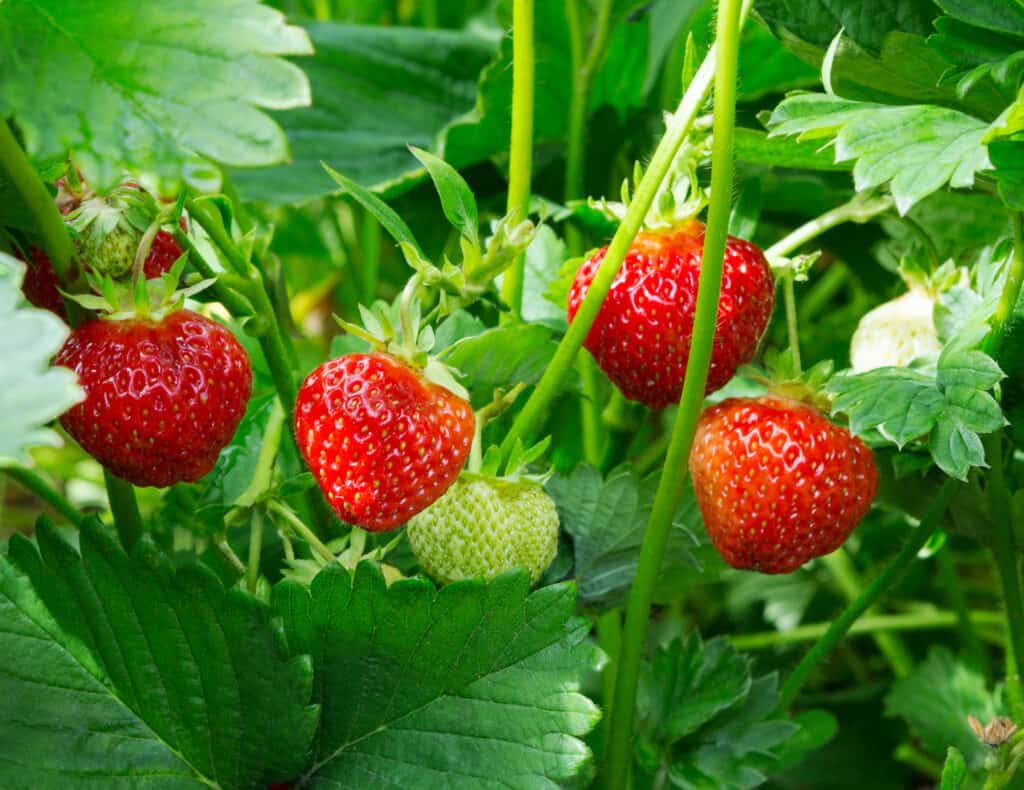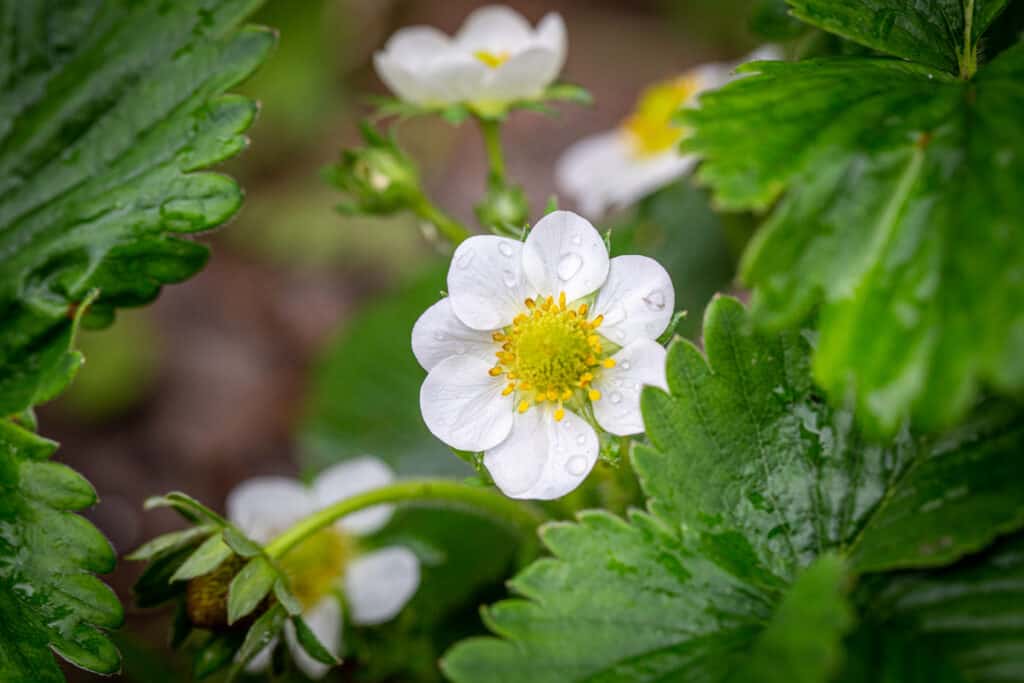Strawberries and blueberries are two of the world’s favorite flavors, and no doubt you have a preference, but asides from their tastiness what else is different? Let’s discover exactly how strawberries vs. blueberries differ and if there are any similarities.
What’s The Main Difference Between Strawberries and Blueberries?
The first thing that springs to mind is their color. Strawberries are red and blueberries are blue, but there are numerous strawberry cultivars including pink and white versions.
The main differences are strawberries are aggregate fruits while blueberries are berries and strawberries grow on runners along the ground whereas blueberries grow on an upright woody shrub.
| Name | Garden Strawberry Fragaria × ananassa | Blueberry Cyanococcus |
|---|---|---|
| Growing Zones | 4-9 | 4-8 |
| Fruit | Inch-long red juicy fruit with seed on the skin. White or pink fruit on some cultivars. | Rounded deep-blue fruit with seeds in the center. Waxy coating. |
| Foliage | Mid-green, toothed edges, set of three leaves on each stem. | Deep, glossy green oval leaves with a pointed tip. Emerge red and turn red in fall. |
| Perennial or Annual | Perennial, grown as annuals in colder zones | Perennial |
| Toxicity | Not toxic | Not toxic |
The History of Strawberries and Blueberries

Strawberries have a rich and complex history.
©Tim UR/Shutterstock.com
Strawberry cultivars available in stores are most commonly cultivars of the early popular garden strawberry that was bred in France in the 1700s. It was a cross between the wild American strawberry Fragaria virginiana and Chilean Fragaria chiloensis and was discovered in the 1700s by a French expedition who noticed how large the fruit grew in comparison to the tiny wild european strawberries.
The ancient Romans and Greeks cultivated strawberries (Fragaria) and used them in medicine as did the 12th and 13th-century Europeans who ate wild strawberries and use them to treat depression. Strawberry plants appear in historical art from European monk manuscripts to Flemish and German master paintings. Historians have even uncovered the French King Charles V’s love of strawberries. He had over 1,000 strawberry plants in his 12th century garden!
You can read all about the history of strawberries in this article from the Molecular Biology and Evolution Journal.
Blueberries are an American fruit in the genus Vaccinium of the Cyanococcus family. It grows throughout North America and was introduced to Europe in the 1930s.
There are two types of blueberry. One is the wild blueberry, which is called lowbush and grows from four inches to 13 feet tall and the other is the highbush blueberry which is used in cultivation more frequently. It was introduced in New Jersey in the 1900s and is better known as the northern highbush blueberry.
How Did Strawberries Get Their Name?
This is an interesting question and no-one is totally sure. It could be from the ancient habit of growing them in a bed of straw to ward off slugs, snails, and stop soil bruising the fruit. Another suggestion is strewnberry, which describes its haphazard strew-about-the-place growing habit. A final suggestion is because its seeds resemble small pieces of straw chaff stuck in the fruit. Perhaps it’s all three!
In contrast, it’s a simple task to uncover the meaning behind blueberry — its berry is blue! However, Native Americans call blueberries star fruit because the flared end resembles a star.
Why Do Strawberries Have So Many Seeds?
Strawberries are not actually berries but aggregate fruits like raspberries, loganberries, and blackberries. This means the seeds accumulate on the outside of the fleshy parts, rather than in the center as blueberries do. On average, strawberries hold 200 seeds on their outer membrane, but in contrast, blueberries have 20-50 seeds held in their center.
Strawberries vs. Blueberries: Native Range

Blueberries are native to the US, though wild blueberries are tiny compared to cultivated varieties.
©Bukhta Yurii/Shutterstock.com
Blueberries are native to North America, and the most common garden strawberry was developed in France from a Chilean strawberry and an American strawberry. Wild strawberries are native to most of the temperate, subtropical, and tropical world.
Strawberries vs. Blueberries: Growing Zones
Strawberries grow in zones 4-9, but it’s best to check the cultivar because some are more cold-hardy than others. Blueberries have a similar range and will fruit readily in zones 4-8.
How Do Strawberries and Blueberries Fruit Differ?
Blueberry fruits are small measuring only up to 5/8 of an inch. They have a flared end and range from deep blue to purple. Each blueberry is covered with protective wax called the bloom. It keeps rain, disease, and pests off. Blueberries with lots of waxy bloom are the freshest.
Strawberry fruits start life tiny and green before maturing to pale green, white and eventually red when they’re ripe. There are some cultivars that produce white fruit with red seeds! Strawberries can reach over an inch in length depending on the cultivar, but wild strawberries reach a maximum of ½ an inch.
Strawberry fruits spoil much faster than blueberries because they are easily bruised and eaten by pests, but both fruits are very tasty and packed full of health benefits.
Strawberries vs. Blueberries: Foliage

Strawberry leaves have serrated edges.
©iStock.com/romiri
Strawberry foliage has toothed margins. Most cultivars have light to dark green, matte leaves with silky hair on the underside. Leaves are arranged in groups of three on a single stem.
In contrast, shiny blueberry leaves start life with a reddish tinge and grow to about one to two inches long before turning dark green. The leaves are pointed, paler beneath, and turn rich red in fall.
Both plants are deciduous which means they lose their foliage in winter.
Strawberry vs. Blueberry: Flowers

A bumblebee collecting nectar from blueberry flowers
©iStock.com/skiden
Blueberry flowers are small pink or white bells arranged in dangling sprays. Blueberry flowers are so pretty that gardeners sometimes grow blueberries just for their flower display.
Strawberry flowers are also small and white, but they are sky-facing five-petalled stars with a yellow center.
Both strawberry and blueberry flowers are attractive to pollinators, especially bees.
Can Dogs Eat Strawberries or Blueberries?
Dogs can eat strawberries and blueberries, but too many can cause an upset stomach (it’s the same for humans!), so it’s best not to let your pup have unrestricted access to them.
If you’re unsure, choose a supplement containing safe amounts.
How to Grow Strawberries and Blueberries
Both strawberries and blueberries are very easy to grow. They’re good fruits to choose if you want to get kids more involved in the garden.
Growing Blueberries

Blueberry leaves are pointed at the end, paler on the underside, and turn red in the fall.
©Maria Dryfhout/Shutterstock.com
Both low-bush and high-bush blueberries grow best on neutral to acidic soil with a pH of 4.2 to 5.5, In alkaline soil, blueberries will develop an iron or magnesium deficiency called chlorosis that causes spindly stems and pale-yellow foliage. If you’re not sure, try growing blueberries in a large well-watered and fed container of ericaceous (acid-based) compost.
Blueberries need full sun to partial shade and lots of water or the flower will fall off and you’ll have no berries to harvest. After the fruiting season is over, cut away one out of every three canes at the base because blueberries fruit best on new canes.
Growing Strawberries

Strawberry flowers.
©iStock.com/nicksus
Strawberries grow quite differently and they take up much less space. They’ll even grow in a hanging basket on a balcony. You can grow them from seed, but it’s easier to buy a plant or cut off a runner (more on that later).
First off, decide if you want summer fruiting or fall fruiting strawberries and choose the right cultivar type.
Plant strawberries 14 inches apart in full sun to partial shade in any type of well-drained rich soil and keep them watered. Strawberries need plenty of well-rotted organic matter because they are hungry plants, so mulch and fertilize them regularly as soon as the flowers appear. If you have summer fruiting strawberries cut the crown back after it’s finished fruiting.
In winter blueberries will fend for themselves, and strawberries will do the same but they can be frost sensitive, it’s best to cover them with pots, fleece, cloches, or if they’re in containers, bring them inside in cold areas.
Are They Perennial?
Blueberries and strawberries are both perennials. The best blueberry fruits grow on newer stems from the previous few years.
Strawberries tend to stop fruiting after a few years and die off after six to seven years. In cold zones, they can be grown as annuals, but will readily survive winter if their roots are well drained and they are protected from the worst frosts
Strawberries and Blueberries: Propagation
Blueberry shrubs can be propagated by hardwood or softwood cuttings.
Hardwood: In late winter, choose a five-inch long stem from last year’s growth. Cut it, and remove the bottom half’s foliage. Push the stem into a pot of gritty compost and keep it damp. Look for new growth in early spring.
Softwood: In early spring choose a five-inch stem from new growth. Remove all but two of the topmost leaves and push it into a pot of gritty compost. New growth will appear in three to four weeks.
Strawberries are much easier to propagate! Just look for long thin stems thrown out of the main plant. They are called runners. All you do is peg them into the ground, or cut them away and plant them in a container. A new strawberry plant will grow straight away and most likely fruit the next year.
Up Next
- Huckleberries vs Blueberries: Is There a Difference?
- Bilberries vs Blueberries: What’s the Difference?
- Raspberries vs Blueberries: What Are the Differences?
The photo featured at the top of this post is © vaivirga/Shutterstock.com
Sources
- Abby Medieval Festival, Available here: https://abbeymedievalfestival.com/2016/06/strawberries/
- The Royal Horticultural Society, Available here: https://www.rhs.org.uk/advice/grow-your-own/features/history-of-the-strawberry#:~:text=It%20is%20hard%20to%20believe,both%20North%20and%20South%20America
Thank you for reading! Have some feedback for us? Contact the AZ Animals editorial team.






